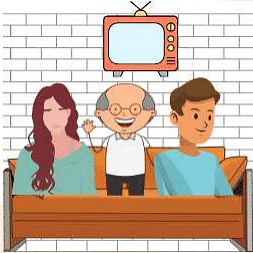Class 3 Exam > Class 3 Notes > EVS for Class 3 > Summary: Families can be Different
Summary: Families can be Different | EVS for Class 3 PDF Download
Summary
This chapter will help us to understand what a family is, its importance, and the different types of families we see around us.
Families can be of basically two types:
- Joint Family - A joint family is one in which grandparents, parents, uncles, aunts, and cousins all live in the same house.
- Nuclear Family - Nuclear families are those in which the father, mother, and children all live under the same roof.
Sitamma’s Family:
- Sitamma lives in Guntur, a small town, in her ancestral home.
- On the ground floor, her dada, dadi, younger chacha, and bua live.
- Sitamma shares a section of the first floor with her father, mother, and younger sister Gitamma. Her tauji and his three children live in the other half of the house.
- Her taiji had recently passed away. Her elder chacha and the new chachi share one of the terrace rooms. They are newlyweds.
- Sitamma's mother teaches all the children before dinner.
- On the ground floor, food for the entire family is prepared in the same kitchen.
- They make a concerted effort to eat dinner together.
- Tauji's younger daughter now spends the night with Sitamma's mother. Sitamma assists her in getting ready for school in the morning.
So, we can see Sitamma’s family is an example of a Joint family where everyone stays together.
Tara’s Family
- Tara lives in Chennai with her Amma and nana.
- Meenakshi, her Amma, is not married. Tara has been adopted by her.
- Meenakshi goes to work in the morning and comes home at night.
- Tara's nana looks after her when she gets home from school.
- He feeds her, assists her with her homework, and also plays with her.
- During their vacations, the three of them travel to far-flung locations and have a good time.
- Tara's Mausi, mausa, and their children visit them from time to time. They chit-chat and play together for long periods at these times.
 Family
Family - Tara’s family is an example of a nuclear family of a different kind where Tara is an adopted child though everyone loves her endlessly.
Sara and Habib
- Sara and Habib are city dwellers. Both are working.
- Sara works as a teacher and Habib works as a clerk in a government office.
- Habib's Abbu, who is now retired, lives with them. The three of them sit together in the evenings to watch television or play cards.
- Abbu enjoys watching TV with his friends. He also enjoys the discussion.
- The children from their next-door neighbors visit them during the holidays and have a great time.
- Everyone has a good time together. They go out, play games, and occasionally see plays and movies.
 Watching TV
Watching TV
So, Sara and Habib’s family is also an example of a nuclear family where they stay with their father.
Totaram’s Family
- Totaram lives in a Mumbai colony with his father, uncle, and cousin brothers.
- Totaram and his brothers are studying in Mumbai. His father and uncle are both employed here.
- Everybody pitches in to help with the household chores. Everyone enjoys the food prepared by Totaram's chacha.
- Totaram's father is in charge of the shopping. Totaram's dada in the village receives a portion of the money earned.
- Totaram’s mother, dada, dadi, Chachi, and younger brothers and sisters live in their parental house in the village.
- Totaram visits his village once a year. He misses his mother. He writes her lengthy letters.
 Writing a letter
Writing a letter
Krishna and Kaveri’s Family
- Krishna, Kaveri, and their father live together. All three of them leave home together in the morning. Krishna goes to college and leaves Kaveri at school.
- Their father goes to the shop for the day.
- After finishing her schoolwork, Kaveri goes out to play. When she gets home, she either plays carrom with her brother or watches TV. When the father returns home, they prepare food and share a meal.
- After finishing her schoolwork, Kaveri goes out to play. When she gets home, she either plays carrom with her brother or watches TV. When the father returns home, they prepare food and share a meal.
- Kaveri spends her summer vacations with her mother. Krishna also spends a few days there, but he prefers to stay in his own home, where all of his belongings and his father are.
 Kaveri reading book
Kaveri reading book
The Theme of the Chapter:
- This chapter shows that different people around have a different family.
- Every person lives and has different rules and beliefs in their family.
- The important and similar thing in the families we have seen is togetherness.
The document Summary: Families can be Different | EVS for Class 3 is a part of the Class 3 Course EVS for Class 3.
All you need of Class 3 at this link: Class 3
|
45 videos|182 docs|48 tests
|
Related Searches
















